Like Stonehenge in southern England, Arctic Henge acts as a kind of huge sundial, capturing sunlight and casting shadows. It has four aligned six-metre-high gates with a 10-metre central column. When completed it will be 52 metres in diameter. It is still being built from locally quarried basalt rock on an outcrop of land in north-east Iceland, overlooking the remote village of Raufarhöfn – the corner of the mainland closest to the Arctic Circle.
The Guardian’s product and service reviews are independent and are in no way influenced by any advertiser or commercial initiative. We will earn a commission from the retailer if you buy something through an affiliate link. Learn more.
Once one of the most important ports for fish processing and the export of herring products, Raufarhöfn fell into decline after the collapse of the industry in the 1960s. The late Erlingur Thoroddsen, a resident hotelier, conceived and began construction of the Arctic Henge in 1996, partly to help revive the town.
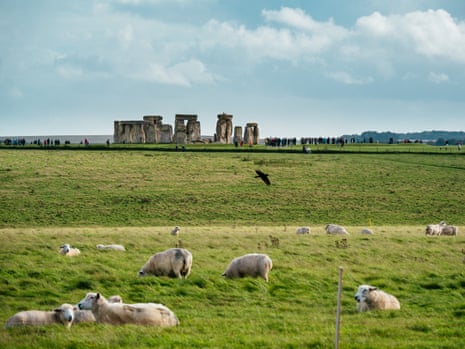
When I relocated to Iceland from London in 2015 to write a book, I sold both my motorcycles. I had been riding since I was 16 and withdrawal soon set in. Then last summer, I heard that a friend from the UK was selling a 250cc Kawasaki TR250. In September I flew to London and bought the bike. I mapped a route to ride it back to Iceland, from Stonehenge to Heimskautsgerðið (Arctic Henge). To avoid the motorways I decided to take the scenic route on what would be the longest solo journey on a motorcycle I had ever made, 3,500km from southern England through France, Belgium, Germany, Denmark, the Faroe Islands and across Iceland.
Arriving in Amesbury, Wiltshire, traffic was bumper to bumper on the A303, but on the bike, I was able to make good progress. At Stonehenge, instead of getting the bus to the actual site, I doubled back and found a turning onto a potholed lane where a few motorhomes were parked up. I had a picnic, and from across the field of sheep, peacefully observed the ancient stones and their swarm of visitors.
After crossing the channel on Eurotunnel, I drove around 350km nearly every day as I made my way through Europe to the ferry in Hirtshals, in the north of Denmark. I stopped off at the homes of friends, or hotels when needed. As I drove further north the land transitioned from the green end of summer, to the burgundy of autumn.
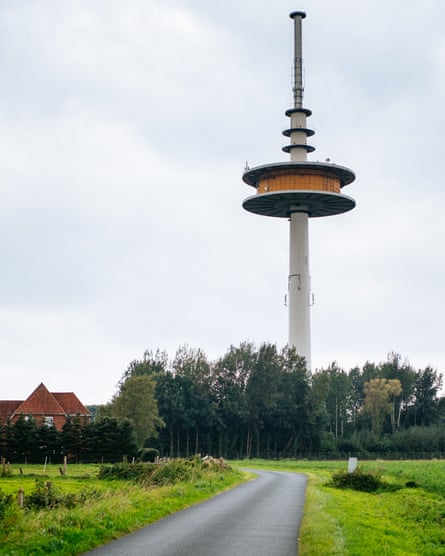
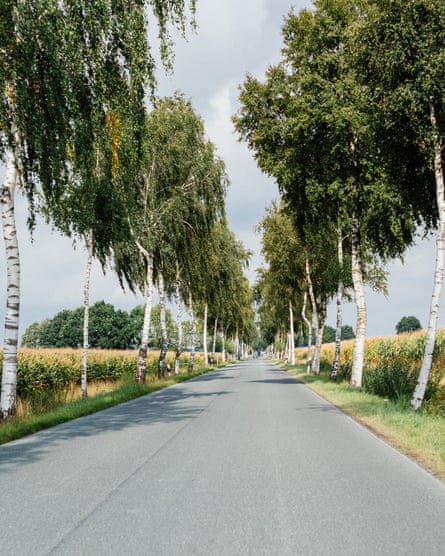
- Germany is full of surprisingly green fields, wind turbines, and the occasional telecom tower
All 250km of tree-lined winding roads from Osnabrück to Hamburg were bathed in beautiful sunshine. National elections were coming up in a few weeks and posters were festooned everywhere. The occasional wrong turn had me driving past farmhouses and cornfields.
In Hamburg I sailed around the city’s waterways on the no. 72 harbour commuter ferry, taking in the sights and the soothing sensation of being on a boat in calm water. The smokestacks of factories puffed swirling clouds into the blue sky as we floated past cranes and modern buildings.

- From Hamburg (above) I drove to Puttgarden for the ferry to Rødby in Denmark.
Arriving in Copenhagen, I headed straight to Wrenchmonkees, a custom motorcycle garage. Here Jonathan, who races professionally, invited me for a ride at Malmö Motorstadion the next day. Driving from Denmark to Sweden across the towering, 8km-long Øresund bridge had my heart pounding and a huge smile plastered on my face.
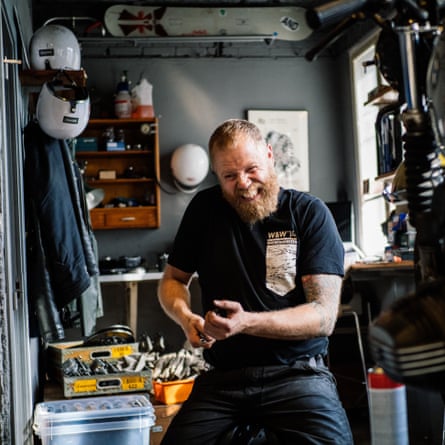

- Wrenchmonkees in Copenhagen is famous in the motorbiking world

- The chance to ride at Malmö Motorstadion made me realise that while my bike was built for dirt track racing, I was not.
The voyage from Hirtshals on the northern tip of Jutland to Tórshavn, capital of the Faroe Islands, takes 36 hours on the MS Norröna (Denmark to Iceland with a stop in Tórshavn from about €320 one-way low season with motorbike and some meals, single cabin, smyrilline.com). It was low season so the ship was not very crowded. Other passengers included senior tourist groups, young European travellers, and commuters. We sat on the top deck under heaters enjoying the view and draught beer.
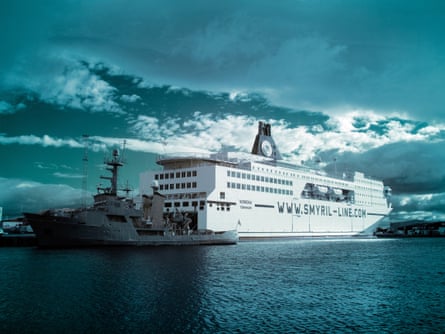
- With restaurants, bars, a pool, sauna, movie theatre, a gym, and outdoor hot tubs, it feels more like a cruise than a North Sea crossing
A day and a half after leaving Jutland we docked in Tórshavn, the capital of the Faroe Islands at 5am. I rolled off the ship in darkness. The ground was steady but my stomach still swayed. I slowly made my way up the harbour to the nearby Hotel Hafnia.
The Faroes are an archipelago made up of 18 islands connected by sea tunnels, bridges and ferries. The next morning I drove to the island of Vágar in near zero visibility and strong winds. The winding mountain roads along rocky cliffs (without railings) were breathtaking but terrifying on the motorbike. I was grateful for the windless 5km sea tunnel that joins the main island of Streymoy (where Tórshavn is) to the island of Vágar.

- Locals in the Faroes spoke about the growing number of visitors and hoped the influx wouldn’t overwhelm their lives and infrastructure
On Vágar I took a walk from my hotel. I could see roads snaking like a distant continuation of the path I was on, just beyond the ocean’s bay. Sheep and traditional black houses dotted the fjord which felt more sombre than the images I’d seen on Instagram.

- The Faroe Islands have an otherworldly feel to them. This image, taken on the island of Vágar, is photographed in infrared
The 19-hour voyage to Iceland was forecast to be more turbulent than the one from Denmark. As soon as I checked in, I took motion sickness pills. With medication on my side, I spent the evening enjoying a meal of fish tempura and roasted vegetables despite the boat taking on six-metre swells.


- I was told that sitting in water could help with motion sickness so I hired one of the outdoor hot tubs for a soak
A calm sunrise arrival into Seyðisfjörður was overshadowed by news that a storm was due to hit the area that evening. I was booked into Grásteinn (doubles from about £150 B&B) on Holt sheep farm in Þórshöfn, 225km to the north (five hours drive away) on a working sheep farm in Þórshöfn. If I left immediately, I would make it. The promise of friendly faces and roast lamb was enough to galvanise me. On just a couple of hours’ sleep, I began the ascent from Seyðisfjörður.
Taking the ring road out of Egilsstaðir, the wind picked up and the chill began to penetrate. There was snow on the peaks ahead. After 83km I turned off onto Route 85 and climbed to Vöpnafjörður. This road traverses gorges and rivers. I felt like I was driving into endless sky.

- Riding is a meditation. So much of modern life is constructed to keep us out of our environments, disconnected from them, or each other. “Safe”. This is an antidote to that
I was greeted at Grásteinn guesthouse by the dogs first, then the farmers Hildur and Siggi, their children and their German “workaway” Romi who showed me to my cabin. Unplugged from world media for weeks, I learned that the Iceland football team was due to play a key World Cup qualification match against Kosovo. Needless to say, the country was dizzy over it.
The ram auction that Saturday in Raufarhöfn meant we would all go together. The farmers loaded their rams into a truck and I readied my bike for the one-hour drive to the Arctic Henge. After winding my way through the green and burnt-orange moss-covered lava fields, I turned into the stark area around Raufarhöfn. Not many tourists make it this far off the ring road, but the Arctic Henge is changing that.

- Leaving the city limits of Akureyri, northern Iceland
As the triangular peaks of the four gates emerged on the horizon, the hairs on the back of my neck stood up. A handful of tourists were walking among the stone columns and marvelling at their size with outstretched arms. I parked the bike and Romi drove up behind me. Grinning, I asked her to take a photo of me in full gear.
It was October 7 and I had covered more than 3,500km. After one more night’s rest, I completed the journey to Reykajvík via the northern ring road stopping overnight in Akureyri. I then drove the familiar majestic winding blacktop roads towards Borgarnes on the west coast, across the bridge spanning the Borgarfjörður fjord, and was home. Iceland qualified for the World Cup two hours later.

- End of the road – heading to Borgarnes on the west coast
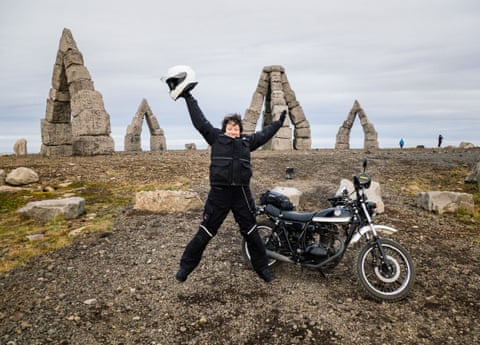
Comments (…)
Sign in or create your Guardian account to join the discussion